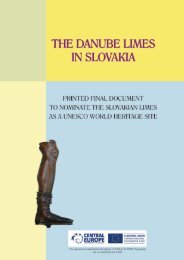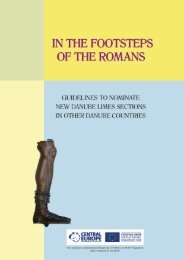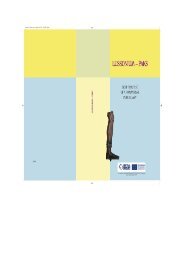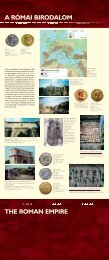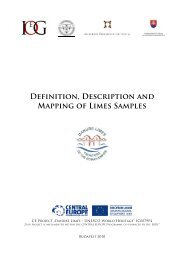the PDF version! - Danube Limes
the PDF version! - Danube Limes
the PDF version! - Danube Limes
Create successful ePaper yourself
Turn your PDF publications into a flip-book with our unique Google optimized e-Paper software.
Frontiers of <strong>the</strong> Roman Empire – Ripa Pannonica in Hungary (RPH) Nomination statement<br />
Section 3. The National Regional Development Plan includes <strong>the</strong> structural plans for <strong>the</strong> country as well<br />
as <strong>the</strong> regional zones of <strong>the</strong> country and <strong>the</strong> regulations related to <strong>the</strong>se.<br />
Section 4. (1) The regulations related to land use and construction in <strong>the</strong> country’s towns and individual<br />
regions must be framed in accordance with <strong>the</strong> provisions of this law.<br />
Section 14/B The World Heritage and tentative World Heritage sites or historic town districts must<br />
be counted as areas to be administered as a high priority from a cultural heritage standpoint in <strong>the</strong><br />
zones in <strong>the</strong> highlighted regional and county area development plans, and must be defined through <strong>the</strong><br />
delimitation of <strong>the</strong> affected town’s administrative territory.<br />
An appropriate border for <strong>the</strong> actual extent of <strong>the</strong> zones for <strong>the</strong> above sites must be determined in <strong>the</strong><br />
town development plan.<br />
Considering that in some cases <strong>the</strong> individual sites of <strong>the</strong> World Heritage site extend into several towns,<br />
<strong>the</strong> provision in <strong>the</strong> law related to this is extremely important:<br />
Chapter V, section 16/B (1) For <strong>the</strong> administration – defined in law – of shared town development and<br />
town planning duties that are included in <strong>the</strong> zone for areas that can be jointly planned a combined<br />
simplified town structural plan may be prepared.<br />
(2) The sections related to <strong>the</strong> individual towns in <strong>the</strong> combined simplified town structural plans are<br />
adopted through ordinances by <strong>the</strong> affected town governments.<br />
The law also contains <strong>the</strong> obligation to designate buffer zones:<br />
Chapter VI, section 21 (5) In <strong>the</strong> town structural plan, <strong>the</strong> regulatory plan and <strong>the</strong> local building<br />
regulations <strong>the</strong> border of <strong>the</strong> townscape preservation district must be designated, which contains <strong>the</strong> areas<br />
that are valuable to <strong>the</strong> landscape and are to be administered as a high priority from a cultural heritage<br />
standpoint, areas of <strong>the</strong> ecological network, nature conservation areas under national or local protection<br />
and <strong>the</strong>ir surroundings, as well as important character defining areas for <strong>the</strong> appearance of <strong>the</strong> town.<br />
The law protects World Heritage sites and tentative World Heritage sites<br />
with special zoning provisions:<br />
Chapter VI, section 22/A (1) In <strong>the</strong> zone of World Heritage and tentative World Heritage sites <strong>the</strong> method<br />
and extent of land use must be in harmony with <strong>the</strong> objectives defined in <strong>the</strong> management plan.<br />
(2) In this zone, new surface mining operations may not be introduced and existing surface mining<br />
operations may not be expanded.<br />
(3) In this zone, networks and structures for transportation infrastructure must be located so as not to<br />
damage <strong>the</strong> character of <strong>the</strong> cultural heritage, and so as to preserve <strong>the</strong> site’s unity and to contribute to<br />
<strong>the</strong> assertion of its appearance.<br />
(4) In this zone, public utility lines and accompanying public utility structures must be located in a<br />
manner that integrates into <strong>the</strong> landscape, and that utilizes technical solutions that do not impede <strong>the</strong><br />
preservation of <strong>the</strong> World Heritage sites, including <strong>the</strong> placement of lines underground.<br />
81



